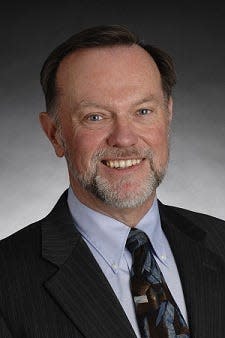Nagy: Why Ukrainian refugees are not like migrants at southern border
Writing about refugees for me is always difficult: having been one myself, I harbor a deep-rooted sympathy for anyone forced to flee their homeland for any reason. But when I heard President Biden compare refugees fleeing Russia’s barbaric invasion of Ukraine with people seeking entry to the US on our southern border, I was taken aback. Our president either lacks a fundamental understanding of what criteria makes someone a “refugee,” or he is spinning a deeply politicized issue which has sharply divided Americans for decades.

In case anyone missed Biden’s remarks while visiting Ukrainian refugees in Poland, the President declared, “We do acknowledge Poland has taken on a lot with all of the responsibility" …"The fact that you have so many Ukrainians seeking refuge in this country … We understand that, because we have at our southern border, thousands of people per day literally, not figuratively, trying to get into the United States…"
Poland has indeed “taken on a lot.” Of the approximately 4 million refugees created by Russia’s Ukraine invasion, Poland has taken in over half, with Romania, Moldova, Hungary, and Slovakia hosting most of the rest. On a comparative basis, this would be like the US taking in 20 million arrivals! Much more modestly, Biden has promised that the US would accept 100,000 Ukrainians. (In 1957, my dad and I were allowed into the US with about 30,000 other Hungarian refugees escaping the Soviet invasion which quelled our short-lived revolution.)
But what makes someone a “refugee?” Simply stated, refugees have no choice; they leave because they face some personal physical risk — e.g., war, conflict, violence, persecution — and cross an international border. The 1951 International Refugee Convention defines a refugee as “someone who is unable or unwilling to return to their country of origin owing to a well-founded fear of being persecuted for reasons of race, religion, nationality, membership of a particular social group, or political opinion.” Migrants, on the other hand, are going to another country for a better life. There are international treaties on how to deal with “refugees” — such as granting asylum and resettling them. Migrants, however, have few formal protections, and sovereign nations have the right to bar them or to expel them if they gain entry illegally.
With the people fleeing Ukraine there can be no question about whether they meet the legal definition. Given Russia’s indiscriminate violence, such as bombing medical facilities or a building clearly marked “Children,” or shooting an elderly World War II Holocaust survivor, those 4 million are bona fide refugees. They were set in motion by a clearly defined event — Russia’s attack on Ukraine — and the great majority appear to be children and the elderly, with the able bodied remaining behind to fight the invaders. As Biden acknowledged during his recent visit: “See all those little children?” the president asked rhetorically to reporters at the stadium, “each one of those children said, ‘Say a prayer for my dad, for my grandfather, for my brother,” because they are “back there fighting.’” And those who have had to flee are anxiously and eagerly hoping to return to Ukraine as soon as they can, to reconnect with their family members and their country.
On our southern border, the situation is quite different. As the president said, there are indeed “thousands showing up each day” — last year our border guards intercepted over 2 million “unauthorized migrants” seeking entry to the US (and that doesn’t count those who made it in.) But the great majority are single adults who would meet the definition of economic migrants, not refugees. They are not fleeing a sudden cataclysm — like the Ukraine war — but seeking a better life, coming from countries which for decades have been characterized by misrule, corruption, and poverty. Of course, there are among the multitude individuals with legitimate claims for asylum; unfortunately, our dysfunctional border policies and inadequate resources cannot quickly distinguish between them and the economic migrants.
The Ukrainian refugees cannot get back home quickly enough, and I pray that by hanging tough, our Western alliance helps them do so. I know from personal experience no one wakes up one morning and says, “Gee, I want to be a refugee!” I was very happy living in Hungary as a little boy and going through the refugee experience was beyond traumatic. So, President Biden is wrong to compare the situation of those who have absolutely no choice in fleeing the home they love, with those who make a decision — as difficult as it is — to go elsewhere. And for those arriving on our southern border — all indications are that the numbers will grow dramatically in coming months — President Biden should quickly understand how to differentiate between refugees and migrants.
Ambassador Tibor Nagy was most recently Assistant Secretary of State for Africa after serving as Texas Tech’s Vice Provost for International Affairs and a 30-year career as a US Diplomat.
This article originally appeared on Lubbock Avalanche-Journal: Tibor Nagy Ukrainian refugees are not like migrants at southern border
